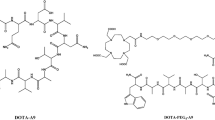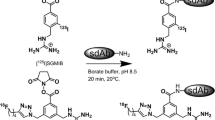Abstract
Background
Peptide receptor radionuclide therapy (PRRT) has evolved in cancer therapy and diagnosis. LTVSPWY, as a peptide, can target HER2 receptor; on the other hand, 177Lu emits β− which is helpful for cancer therapy. The radiolabeling of LTVSPWY with 177Lu results in a therapeutic agent (177Lu-DOTA-LTVSPWY) capable of cancer treatment.
Methods
177Lu-DOTA-LTVSPWY was prepared with high radiochemical purity (RCP). The stability was investigated in saline and human serum. The radiotracer affinity toward the SKOV-3 cell line with overexpression of the HER2 receptor was evaluated. Then the impact of the radiotracer on the colony formation of the SKOV-3 cell line was investigated with colony assay. Moreover, the biodistribution of this radiotracer in SKOV-3 xenograft tumor-bearing nude mice were also studied to determine the radiotracer accumulation in the tumor site. The mice were treated with 177Lu-DOTA-LTVSPWY and subjected to histopathological evaluation.
Results
The RCP of 177Lu-DOTA-LTVSPWY after radiolabeling and stability tests was more than 97.7%. The radiotracer displayed high affinity toward the SKOV-3 cell line (KD = 6.6 ± 3.2 nM). Treatment of the SKOV-3 cell line with the radiotracer reduces the SKOV-3 colony survival to less than 3% for 5 MBq of the radiotracer. Tumor-to-muscle (T/M) ratio is the highest at 48 h and 1 h post-injection (2.3 and 4.75, respectively). The histopathological study also confirms the cellular damage to the tumor tissue.
Conclusions
177Lu-DOTA-LTVSPWY can recognize HER2 receptors in vivo and in vitro; hence, it can serve as a therapeutic agent.






Similar content being viewed by others
Availability of data and materials
The data that support the findings of this study are original and not obtained from any publications or elsewhere. Data are available from the corresponding author upon reasonable request.
References
Sauter G, Lee J, Bartlett JM, Slamon DJ, Press MF. Guidelines for human epidermal growth factor receptor 2 testing: biologic and methodologic considerations. J Clin Oncol. 2009;27:1323–33.
Molavipordanjani S, Hosseinimehr SJ. The Radiolabeled HER3 targeting molecules for tumor imaging. Iran J Pharm Res IJPR. 2021;20:141.
Sun X, Wang S, Gai J, Guan J, Li J, Li Y, et al. SIRT5 promotes cisplatin resistance in ovarian cancer by suppressing DNA damage in a ROS-dependent manner via regulation of the Nrf2/HO-1 pathway. Front Oncol. 2019;9:754.
Yoo J, Park C, Yi G, Lee D, Koo H. Active targeting strategies using biological ligands for nanoparticle drug delivery systems. Cancers. 2019;11:640.
Varmira K, Hosseinimehr SJ, Noaparast Z, Abedi SM. A HER2-targeted RNA aptamer molecule labeled with 99mTc for single-photon imaging in malignant tumors. Nucl Med Biol. 2013;40:980–6.
Varmira K, Hosseinimehr SJ, Noaparast Z, Abedi SM. An improved radiolabelled RNA aptamer molecule for HER2 imaging in cancers. J Drug Target. 2014;22:116–22.
Ulaner GA, Hyman DM, Ross DS, Corben A, Chandarlapaty S, Goldfarb S, et al. Detection of HER2-positive metastases in patients with HER2-negative primary breast cancer using 89Zr-trastuzumab PET/CT. J Nucl Med Offil Publ Soc Nucl Med. 2016;57:1523–8.
McLarty K, Cornelissen B, Cai Z, Scollard DA, Costantini DL, Done SJ, et al. Micro-SPECT/CT with 111In-DTPA-pertuzumab sensitively detects trastuzumab-mediated HER2 downregulation and tumor response in athymic mice bearing MDA-MB-361 human breast cancer xenografts. J Nucl Med Offil Publ Soc Nucl Med. 2009;50:1340–8.
Sörensen J, Velikyan I, Sandberg D, Wennborg A, Feldwisch J, Tolmachev V, et al. Measuring HER2-receptor expression in metastatic breast cancer using [68Ga]ABY-025 Affibody PET/CT. Theranostics. 2016;6:262–71.
Keyaerts M, Xavier C, Heemskerk J, Devoogdt N, Everaert H, Ackaert C, et al. Phase I study of 68Ga-HER2-nanobody for PET/CT assessment of HER2 expression in breast carcinoma. J Nucl Med Offil Publ Soc Nucl Med. 2016;57:27–33.
Khodadust F, Ahmadpour S, Aligholikhamseh N, Abedi SM, Hosseinimehr SJ. Corrigendum to “An improved (99m)Tc-HYNIC-(Ser)(3)-LTVSPWY peptide with EDDA/tricine as co-ligands for targeting and imaging of HER2 overexpression tumor.” Eur J Med Chem. 2018;157:782 (EJMECH 144, (2018) 767–773).
Biabani Ardakani J, Talebpour Amiri F, Khorramimoghaddam A, Abbasi A, Molavipordanjani S, Hosseinimehr SJ. Preclinical pharmacokinetic, biodistribution, radiation dosimetry, and toxicity studies of (99m)Tc-HYNIC-(Ser)(3)-LTVPWY: a novel HER2-targeted peptide radiotracer. Regul Toxicol Pharmacol : RTP. 2020;112: 104591.
Ranjbar V, Molavipordanjani S, Biabani Ardakani J, Akhlaghi M, Nikkholgh B, Hosseinimehr SJ. Initial preclinical evaluation of 68 Ga-DOTA-(Ser) 3 -LTVSPWY peptide as a PET radiotracer for glioblastoma targeting and imaging. Nucl Med Commun. 2022;43:945–51.
Stringaro A, Serra S, Gori A, Calcabrini A, Colone M, Dupuis ML, et al. Peptide-mediated targeted delivery of Aloe-Emodin as anticancer drug. Molecules. 2022;27:4615.
Ebrahimi F, Noaparast Z, Abedi SM, Hosseinimehr SJ. Homodimer 99mTc-HYNIC-E (SSSLTVPWY) 2 peptide improved HER2-overexpressed tumor targeting and imaging. Med Oncol. 2022;39:1–15.
Shahsavari S, Shaghaghi Z, Abedi SM, Hosseinimehr SJ. Evaluation of (99m)Tc-HYNIC-(ser)(3)-LTVPWY peptide for glioblastoma imaging. Int J Radiat Biol. 2020;96:502–9.
Avan Z, Biabani Ardakani J, Talebpour Amiri F, Abedi SM, Hosseinimehr SJ. The potential usefulness of (99m)Tc-HYNIC-(Ser)(3)-LTVPWY peptide for predicting HER2 status alteration after chemotherapy in ovarian tumor-bearing mice. Cancer Biother Radiopharm. 2020;37:862–9.
Ardakani JB, Abedi SM, Mardanshahi A, Shojaee L, Zaboli E, Khorramimoghaddam A, et al. Molecular imaging of HER2 expression in breast cancer patients using the [99mTc] Tc-labeled small peptide. Clin Breast Cancer. 2023;23:219–30.
Shalgunov V, Engudar G, Bohrmann L, Wharton L, Maskell K, Johann K, et al. Radiolabeling of a polypeptide polymer for intratumoral delivery of alpha-particle emitter, 225Ac, and beta-particle emitter, 177Lu. Nucl Med Biol. 2022;104:11–21.
Pijeira MSO, Viltres H, Kozempel J, Sakmár M, Vlk M, İlem-Özdemir D, et al. Radiolabeled nanomaterials for biomedical applications: radiopharmacy in the era of nanotechnology. EJNMMI Radiopharm Chem. 2022;7:1–36.
Jerusalem G, Lancellotti P, Kim SB. HER2+ breast cancer treatment and cardiotoxicity: monitoring and management. Breast Cancer Res Treat. 2019;177:237–50.
Dempsey N, Rosenthal A, Dabas N, Kropotova Y, Lippman M, Bishopric NH. Trastuzumab-induced cardiotoxicity: a review of clinical risk factors, pharmacologic prevention, and cardiotoxicity of other HER2-directed therapies. Breast Cancer Res Treat. 2021;188:21–36.
Choong GM, Cullen GD, O’Sullivan CC. Evolving standards of care and new challenges in the management of HER2-positive breast cancer. CA Cancer J Clin. 2020;70:355–74.
Wållberg H, Ståhl S. Design and evaluation of radiolabeled tracers for tumor imaging. Biotechnol Appl Biochem. 2013;60:365–83.
Hrynchak I, Santos L, Falcão A, Gomes CM, Abrunhosa AJ. Nanobody-based theranostic agents for HER2-positive breast cancer: radiolabeling strategies. Int J Mol Sci. 2021;22:10745.
Dalm SU, Verzijlbergen JF, De Jong M. Review: receptor targeted nuclear imaging of breast cancer. Int J Mol Sci. 2017;18:260.
Kręcisz P, Czarnecka K, Królicki L, Mikiciuk-Olasik E, Szymański P. Radiolabeled peptides and antibodies in medicine. Bioconjug Chem. 2021;32:25–42.
Sabahnoo H, Noaparast Z, Abedi SM, Hosseinimehr SJ. New small (99m)Tc-labeled peptides for HER2 receptor imaging. Eur J Med Chem. 2017;127:1012–24.
Khodadust F, Ahmadpour S, Aligholikhamseh N, Abedi SM, Hosseinimehr SJ. An improved (99m)Tc-HYNIC-(Ser)3-LTVSPWY peptide with EDDA/tricine as co-ligands for targeting and imaging of HER2 overexpression tumor. Eur J Med Chem. 2018;144:767–73.
Biabani Ardakani J, Akhlaghi M, Nikkholgh B, Hosseinimehr SJ. Targeting and imaging of HER2 overexpression tumor with a new peptide-based (68)Ga-PET radiotracer. Bioorg Chem. 2021;106: 104474.
Parus JL, Pawlak D, Mikolajczak R, Duatti A. Chemistry and bifunctional chelating agents for binding (177)Lu. Curr Radiopharm. 2015;8:86–94.
Gharibkandi NA, Molavipordanjani S, Mardanshahi A, Hosseinimehr SJ. The influence of kidneys ion transport inhibitors on the pharmacokinetic and tumor uptake behaviors of a HER2-targeted small size radiolabeled peptide. Curr Drug Metab. 2022;23:82–7.
Ebrahimi F, Noaparast Z, Abedi SM, Hosseinimehr SJ. Homodimer (99m)Tc-HYNIC-E(SSSLTVPWY)(2) peptide improved HER2-overexpressed tumor targeting and imaging. Med Oncol. 2022;39:204.
Chen H, Jacobson O, Niu G, Weiss ID, Kiesewetter DO, Liu Y, et al. Novel “Add-On” molecule based on Evans blue confers superior pharmacokinetics and transforms drugs to theranostic agents. J Nucl Med. 2017;58:590–7.
Chen H, Wang G, Lang L, Jacobson O, Kiesewetter DO, Liu Y, et al. Chemical conjugation of Evans blue derivative: a strategy to develop long-acting therapeutics through albumin binding. Theranostics. 2016;6:243–53.
Ehlerding EB, Lan X, Cai W. “Albumin Hitchhiking” with an Evans blue analog for cancer theranostics. Theranostics. 2018;8:812–4.
Langbein T, Wurzer A, Gafita A, Robertson A, Wang H, Arçay A, et al. The influence of specific activity on the biodistribution of (18)F-rhPSMA-7.3: a retrospective analysis of clinical PET data. J Nucl Med. 2022;63:742–5.
Soeda F, Watabe T, Naka S, Liu Y, Horitsugi G, Neels OC, et al. Impact of (18)F-PSMA-1007 uptake in prostate cancer using different peptide concentrations: preclinical PET/CT study on mice. J Nucl Med. 2019;60:1594–9.
Wurzer A, Pollmann J, Schmidt A, Reich D, Wester HJ, Notni J. Molar activity of Ga-68 labeled psma inhibitor conjugates determines PET imaging results. Mol Pharm. 2018;15:4296–302.
Walrand S, Jamar F. Renal and red marrow dosimetry in peptide receptor radionuclide therapy: 20 years of history and ahead. Int J Mol Sci. 2021;22:8326.
Kolasińska-Ćwikła A, Łowczak A, Maciejkiewicz KM, Ćwikła JB. Peptide receptor radionuclide therapy for advanced gastroenteropancreatic neuroendocrine tumors—from oncology perspective. Nucl Med Rev Cent East Eur. 2018. https://doi.org/10.5603/NMR.2018.0019.
Funding
The research reported in this publication was supported by Mazandaran University of Medical Sciences under the grand 1432.
Author information
Authors and Affiliations
Contributions
SJH designed and supervised the study, carried out data analysis and drafted the manuscript; SM carried out data collection and data analysis and drafted the manuscript. TM, AK and FT carried out data collection and data analysis. SMA participated in data collection. All authors read and approved the final manuscript.
Corresponding author
Ethics declarations
Conflict of interest
The authors have not disclosed any conflict of interest.
Ethical approval and consent to participate
The animal study was approved by the Mazandaran University of Medical Sciences (ID #IR.MAZUMS.REC.1397.1432).
Consent for publication
Not applicable.
Additional information
Publisher's Note
Springer Nature remains neutral with regard to jurisdictional claims in published maps and institutional affiliations.
Rights and permissions
Springer Nature or its licensor (e.g. a society or other partner) holds exclusive rights to this article under a publishing agreement with the author(s) or other rightsholder(s); author self-archiving of the accepted manuscript version of this article is solely governed by the terms of such publishing agreement and applicable law.
About this article
Cite this article
Molavipordanjani, S., Mousavi, T., Khorramimoghaddam, A. et al. The preclinical study of 177Lu-DOTA-LTVSPWY as a potential therapeutic agent against HER2 overexpressed cancer. Ann Nucl Med 37, 400–409 (2023). https://doi.org/10.1007/s12149-023-01839-8
Received:
Accepted:
Published:
Issue Date:
DOI: https://doi.org/10.1007/s12149-023-01839-8




